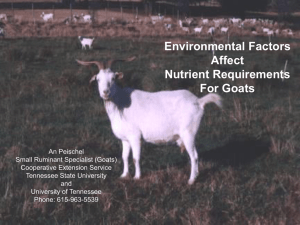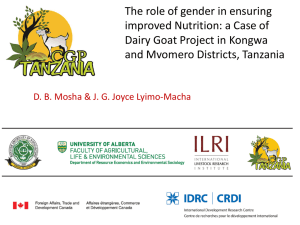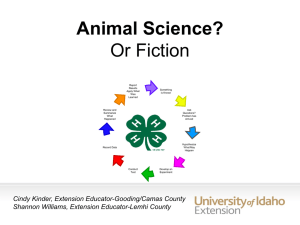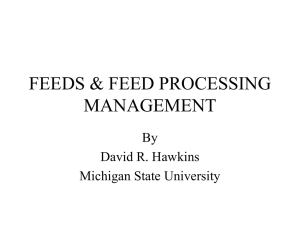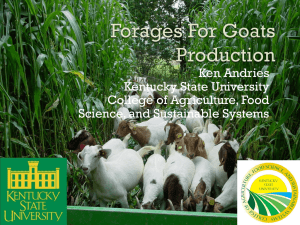Master Cattle Producer
advertisement
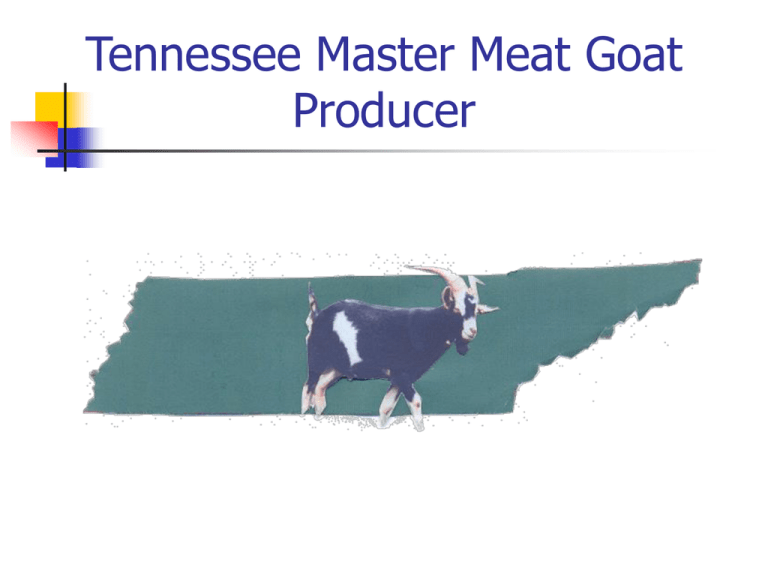
Tennessee Master Meat Goat Producer NUTRITION An Peischel Small Ruminants TSU / UT Warren Gill University of Tennessee Animal Science Department Teaching Objectives Provide nutritional training in order to obtain functional “comfort level” Cover the basics of small ruminant nutrition with an emphasis on forage utilization Evaluate supplementation strategies that assure optimum efficiency Teaching Objectives Assess and cope with factors that influence herd nutritional status Review ration supplementation formulation methods Discuss practical use of common feedstuffs Comparative Capacity of the GI Tract of Different Species 50 Man 40 Pig 30 Cattle 20 10 Sheep & Goats 0 Gastrointestinal Tract, % BW Horse Goat Nutrition FORAGE PREFERENCE BY HERBIVORES Forage type Cattle Sheep Goats Horses Grasses (Pastures) Forbs (Weeds) Browse (Shrubs) 70% 60% 20% 90% 20% 30% 20% 0.04% 10% 10% 60% 0.06% Goat Nutrition HOURS SPENT GRAZING / BROWSING PER DAY 14 C = Cattle S = Sheep G = Goats H = Horses 12 10 8 6 4 2 0 C S G H Nutrient Considerations Goats browse vegetation of lower quality than cattle. Goats utilize leaves, shrubs and stems that cattle avoid. Goats will graze grass and browse forbs/brush closer if not managed effectively. Goats sort grain mixes, therefore, offer supplements pelletized or textured. Browsing is important Goats like to eat with their heads up They select portions with higher nutrient content Browsing is less likely to result in picking up parasites Conformation Conformation and Carcass merit Conformation Carcass merit Carcass merit Nutrient Requirements (on a dry matter basis) 30 lb Kid* 2.0 60 lb Kid* 3.0 TDN, % 68 Protein, % 14 Daily Feed Intake, lb *gaining 0.44 lb/day 80 lb 80 lb. Dry Doe Lact. Doe 4.5 5.0 65 60 65 12 10 14 Guidelines for Goat Supplementation Management Forage is the foundation Successful nutrition is almost always based on forage Pasture, browse or hay must be of adequate quality and quantity Guidelines for Supplementation Management Manage for quality hay Harvest at optimal stage of maturity Forage test to assess quality Store in barn or under cover Minimize soil contact during storage Guidelines for Supplementation Management If needed, supplement efficiently Provide quality mineral supplement Base supplements on forage tests Replacements, first kid does and thin does may need additional supplementation Low quality hay or forage may require supplemental protein Avoid high levels of corn (>0.4% BW) Ruminant Digestion Goats use forages to produce a highquality source of vitamins, minerals, energy and protein in the form of meat and milk This is because they are ruminants Ruminants ruminate – chew the cud Microbes in their digestive system ferment cellulose which non-ruminants (humans, pigs) do not have Ruminant Digestion Main source of energy Humans - glucose Goats - volatile fatty acids (VFA) The compartments of the ruminant digestive system are: Rumen Reticulum Omasum Abomasum Ruminant Digestive Tract Duodenum Small Intestine Rumen Reticulum Rectum Omasum abomasum Pylorus Colon Cecum Large Intestine The Nutrition Program Should be as simple as possible and supply nutrients for the doe to: Give birth to strong healthy kids Produce an adequate amount of milk to maintain kid’s growth Maintain body condition score Rebreed on schedule Principles of Nutritional Management Nutrient needs of goats vary throughout the production cycle Quantity and quality of the feed needed vary throughout the production cycle Forage availability and quality also vary throughout the year. Understanding the above and planning and managing the nutrition program is key to success Water Usually in excess of the need is provided Not necessary to balance rations for water Typically, balance rations as if they do not contain any water to avoid errors associated with mixing feeds of different water contents Fresh, clean and always available Energy Nutrient that is provided in largest quantity and is fuel for the body Total Digestible Nutrients (TDN) is most often used as an energy measure Additional terms to describe efficiency Digestible Energy (DE) Metabolizable Energy (ME) Net Energy (NE) Energy - Fiber Ruminants typically obtain most of their energy from fiber – the microbes ferment (digest) the fiber, turning it into volatile fatty acids which are absorbed and used for energy). Fiber terms: Crude Fiber (CF) Acid Detergent Fiber (ADF) Neutral Detergent Fiber (NDF) Energy – Other sources Plants also supply energy from starch, sugars and other soluble carbohydrates Amount of these products can affect nutritional quality For example, hay cut in the afternoon, after a day of photosynthesis, will be higher in sugar than hay cut in the morning Energy – other sources If forage does not have enough energy to meet the needs of animals, we look for feedstuffs with higher concentrations of energy. Corn – energy from starch Distillers dried grains – energy primarily from fat (fat is most concentrated form of energy) Protein The major component of muscle, hair, hooves, skin, internal organs and body chemicals Composed of smaller units, Amino Acids Goat rations balanced for protein rather than individual amino acids Rumen microbes digest most of protein and change it to microbial protein Protein Crude Protein (CP) - a reliable estimate of the protein content of feedstuffs Another method of expressing protein Metabolizable Protein (MP) system Degradable Intake Protein (DIP) Undegradable Intake Protein (UIP) The MP system takes into account how protein is used by both the animal and the microbes in the rumen Examples of UIP (bypass) and DIP (rumen soluble) Distiller’s Dried grains is a good bypass protein Urea is classic example of 100% rumen soluble crude protein (not used much with goats because of sensitivity to urea toxicity) Vitamins There is usually very little problem with vitamin deficiencies in goats Only Vitamins A,D and E are not synthesized by the rumen microbes They may need to be supplemented if green, leafy forage is not available for several months Vitamin E is essential for utilization of Selenium Minerals Macro-Minerals Sodium and Chlorine are major components in body fluids that control functions, usually assumed adequate Calcium is most abundant mineral in body and functions in structure of bones and teeth Phosphorus is found with calcium in bones and teeth, is essential for reproduction, Ca:P should be app. 2:1 Minerals Macro-Minerals Magnesium is used in enzymes and transmission of nerve impulses; deficiencies result in grass tetany Potassium maintains ion balance; excess makes Mg deficiency (Grass Tetany) more likely Sulfur is required nutrient, but usually in excess in TN, making copper and selenium more likely to be deficient Minerals Micro-Minerals Copper is component in enzymes, deficiency signs are rough hair coat and lower immunity and reproduction Selenium is component in muscle and essential for shedding afterbirth, also important in immune system Zinc is important in function of many enzymes, esp. in immune system Minerals Micro-Minerals Iron is necessary for oxygen transport, but too much can make copper less available Iodine is necessary for energy metabolism, but feed additive is associated with preventing hoof problems Cobalt, Chromium, Nickel and Molybdenum are needed, but not known if they are problems in TN Suggestions for mineral supplement for goats Phosphorus = 4 – 10% Calcium = 2 x Phosphorus Copper = 1500 ppm (higher or lower depending on consumption – organic sources may be preferable) Lower NaCl for goats (< 10%) Magnesium = 2-4% (maybe higher if grass tetany is problem) Selenium = 26 – 52 ppm Cobalt, Iodine, Zinc, Iron, Manganese, Sulfur Mineral Levels by Year in Pasture Mineral 2001 2002 2003 Calcium, % 0.53A 0.53A 0.51A Phosphorus, % 0.36A 0.42A 0.35A Sodium, % 0.01B 0.01A 0.01AB Magnesium, % 0.26A 0.27A 0.26A Potassium, % 2.63A 2.52B 2.56AB A,B,CMineral estimates not sharing the same superscript are significantly different at P < 0.05. Forage Mineral Survey 2001 - 2004 NAHMS (1999) indicated that 74% of tall fescue was deficient in copper Virginia Tech showed that the presence of endophyte decreases copper absorption and utilization Mineral Levels by Year in Pasture Mineral 2001 2002 2003 Sulfur, % 0.28AB 0.27B 0.28A Manganese, ppm Copper, ppm Zinc, ppm A,B,CMineral 106.24B 110.41B 131.32A 7.56A 5.06C 6.90B 24.92B 21.47C 28.05A estimates not sharing the same superscript are significantly different at P < 0.05. Mineral Levels by Season in Pasture Mineral Spring Fall Sulfur, % 0.26B 0.30A 108.52B 123.46A 6.85A 6.17B 22.43B 27.20A Manganese, ppm Copper, ppm Zinc, ppm A,B,CMineral estimates not sharing the same superscript are significantly different at P < 0.05. Keys to Improving Mineral Status Monitor goats for deficiency symptoms Monitor mineral consumption Consult with mineral providers Test forages for mineral content Higher producing goats may have higher requirements Imbalances can be corrected – organic minerals may be indicated Don’t feed high copper mineral to sheep Mineral Toxicity and Nitrate Poisoning Some minerals can be toxic, such as aluminum and fluorine Most minerals have a maximum tolerable concentration (MTC) Copper - 100 ppm Zinc - 500 ppm Manganese - 1000 ppm Selenium - 2ppm Sulfur - 0.4 % Potassium - 3% Mineral Toxicity and Nitrate Poisoning Nitrates are potentially deadly for goats, sheep, goats and horses The vegetative portion of plants contain high levels of nitrates Nitrates are especially high in forages which are stressed by frost, drought, insufficient sunlight and herbicides Potential lethal level - 0.9% (9000 ppm) Steps in Balancing Rations Identify the animals to be supplemented Classify the animals by Weight Age Purpose Lactating Wean-offs Slaughter Vegetation management Steps in Balancing Rations Select nutrient allowances to fit the animal’s need Nutrient requirements are in Table 4 in the text Steps in Balancing Rations Select feeds and supplements to meet nutrient requirements Pasture and hay are the least expensive base feeds in Tennessee (most of the time) Supplemental ingredients should be selected for nutritional value, local availability, price, palatability and safety Steps in Balancing Rations Determine the amounts of each ingredient to use Begin by testing base forage Estimate the amount of base forage, then calculate the nutrients that are lacking A trial-and-error approach works for most common rations Trial and Error Method Step 1 Step 2 Identify animal – 60 lb wether gaining 0.44 lbs per day Select nutrient allowances - Ex. Table 4 of text: 3.0 lb DMI; 1.95 lb TDN; 0.36 lb CP Step 3 Select feeds and supplements - Ex. Table 5 of text: Orchardgrass hay, Corn, Soybean meal Trial and Error Method Step 4 Determine amounts of each feed Example 1. Ration Balancing Sheet Nutrient Requirements Amount Fed DMI lb 3.0 TDN lb 1.95 CP lb 0.36 O. G. hay 2.40 2.14 1.16 0.19 Cracked Corn 0.75 0.68 0.61 0.06 Soybean Meal 0.25 0.22 0.18 0.12 3.4 3.04 1.95 0.37 0 0 0 0 Total Deficiencies Pearson Square Method % CP in Feed 1 Ex. 36% Feed 1 as % of Mixture Ex. 3/27 = 11.1% Target CP Ex. 12% % CP in Feed 2 Ex. 9% Feed 2 as % of Mixture Ex. 24/27 = 88.9% Computer Method Can be very useful for those who balance a large number of rations No ration balancing program or nutritionist is perfect Always observe, weigh and body condition score goats and adjust ration accordingly Factors Affecting Nutrient Requirements 1. 2. 3. 4. 5. 6. 7. Stage of Production Age Size and Body Condition Milk Production Weather / Topography Length of Breeding Season Breed Stage of Production One of the Major Criteria In Planning Nutritional Program Consider the FOUR stages of doe production Environmental Stress Plan for additional feed during cold weather stress Forages produce more heat of fermentation than concentrates Provide shelter Heat stress effects intake, digestibility and the rate of passage Understanding the Feed Label on Purchased Feeds Feed Name May include the product name and brand name and must carefully conform to regulations about appropriateness Understanding the Feed Label on Purchased Feeds Medication Weight If drugs or other non-nutritive, specialpurpose additives are used, they must be on the label along with directions for use and precautions Weight of the bag of feed must be present Purpose Kind of animals that the feed is intended Understanding the Feed Label on Purchased Feeds Guaranteed Analysis Minimum and/or maximum concentrations of nutrients such as Crude Protein, Crude Fat, Crude Fiber, Vitamins and Minerals Understanding the Feed Label on Purchased Feeds Ingredients Feedstuffs that are used to prepare the feed must be listed In some cases, ingredient classes may be used, such as “plant protein byproducts” Company Name and Address This must be included on the label Comparing the Value of Supplements Need to calculate price corrected for nutrient concentration differences 48% CP Soybean Meal @ $245 per ton 0.48 x 2000 = 960 lbs of CP $245 / 960 = 25.5¢ per lb of CP 20% CP Corn Gluten Feed @ $120 per ton 0.20 x 2000 = 400 lbs of CP $120 / 400 = 30¢ per lb of CP The more expensive feed is the more economical source of protein Need to consider energy, physical form How Much Water is in The Feed? High-moisture feed is expensive to transport, likely to spoil and difficult to store Determine the true value of nutrients Add up all costs associated with a feed Convert to a dry matter (DM) basis Nutritional evaluations should always be made on a dry matter basis As-Fed CP% ÷ DM% = CP on DM basis 8% ÷ 40% x 100 = 20% Common By-product Feeds in Tennessee Also called Commodity Feeds, these are feeds that result from the processing or manufacturing of other products Are available in many forms Bagged As part of complete feeds Bulk, by the truckload (most economical) Typical Commodity Feeds to replace Corn and Soybean Meal Oilseeds: Cottonseed and soybeans Energy feeds: Hominy, Bakery waste Energy/Fiber: Soyhulls, Beet pulp, Citrus pulp, Rice bran, Wheat midds Medium protein: Brewer’s grains, Corn gluten feed , Distiller’s grains High protein: Cottonseed meal, Feather meal, Peanut meal Forage extenders: Cottonseed hulls, Peanut hulls, Rice hulls Corn Gluten Feed Description Wet (45% moisture) or Dry form Dry form available as meal or pellets Nutrient composition is variable 16 to 25% CP; 80 to 83% TDN; 44 to 47% NDF; 10 to 12% ADF Ca is low (0.02 – 0.3%) P is 1.2% High in Sulfur Palatability is good Soybean Hulls Description Seed coat removed during oil extraction Typically pelleted High in digestible fiber (>60% NDF) – Referred to as “Forage Friendly Fiber” 80% TDN; 12 to 14% CP; 14% starch Lower starch reduces acidosis; improves performance on forage based diets Demand and prices usually lower in summer Wheat Middlings Description Byproduct of milling wheat for flour 82% TDN; 18% CP; 10% ADF; 1% Phosphorus Routinely used in commercial feeds Price is often attractive when higher protein content is needed in ration Hominy Description A byproduct of corn processing Higher in energy, protein, fat and fiber than corn grain Fat can range from 5 to 12% which will alter TDN concentration and the maximum levels that can be fed Often used as a replacement for corn Feed Additives Available to improve performance, prevent disease or improve feed or forage efficiency Not many approved for goats Products and guidelines are constantly changing Follow manufacturers and Quality Assurance guidelines Evaluation of Nutritional Status Reproductive success and optimum health are linked to nutritional status Nutritional Status Evaluation Body Condition Score Forage Analysis Blood and Liver Analysis Fecal Egg Count and FAMACHA Water Qualtiy Analysis Evaluation of Nutritional Status Body Condition Scoring (BCS) Visual appearance of goats for fleshiness Fluctuates throughout the year Fluctuates with stage of production Fluctuates with nutritional status Affected by stress level Evaluation of Nutritional Status Forage Analysis (Hay / Pasture) Includes moisture, TDN, CP, ADF, NDF and mineral profile Pasture samples are generally for minerals Separate tall fescue pasture samples can be taken for endophyte fungus analysis Evaluation of Nutritional Status Water Quality Analysis Usually only done when there is evidence of a problem with sulfur, iron or other water contaminants Conclusions Long presentation, yet many things were not covered Our Goal has been to give you an idea of how broad and deep the topic of nutriton is There is abundant information available All you have to do is look and ask
